Something I need to say right up front
I am so, so grateful to have been part of the 30th edition of the Hardrock Hundred, which is much more than an ultramarathon. It’s a community, tradition, and celebration with deep roots and international reach. It’s set in arguably the most spectacular mountain range in North America. It’s so small (limited by permit and logistics to 146 participants) that it feels both intimate and exclusive, yet it also feels huge in scale because 600+ volunteers support those of us doing it, and the spectator support in person and virtual is immense. When I think about how this year’s event affected me, I most of all feel loved and supported by family, crew, friends, and countless well-wishers. To everyone who sent me an encouraging message during the event, thank you.
I preface this story with that paragraph because I might leave an impression that I ultimately felt miserable and disappointed, and that more than anything I wanted the ordeal of completing the 102-mile loop to end. I did feel that way for miles, but that doesn’t detract from the deep satisfaction and gratitude I carry.
I’m writing this with a brain that still feels dull with fatigue, a body that still aches going up and down stairs, and a mouth and throat that still hurt to take in food. That’s why it’s coming to you late and wordy.
This is my full crew, for whom I’m grateful most of all. My Hardrock finish was a team effort for sure.
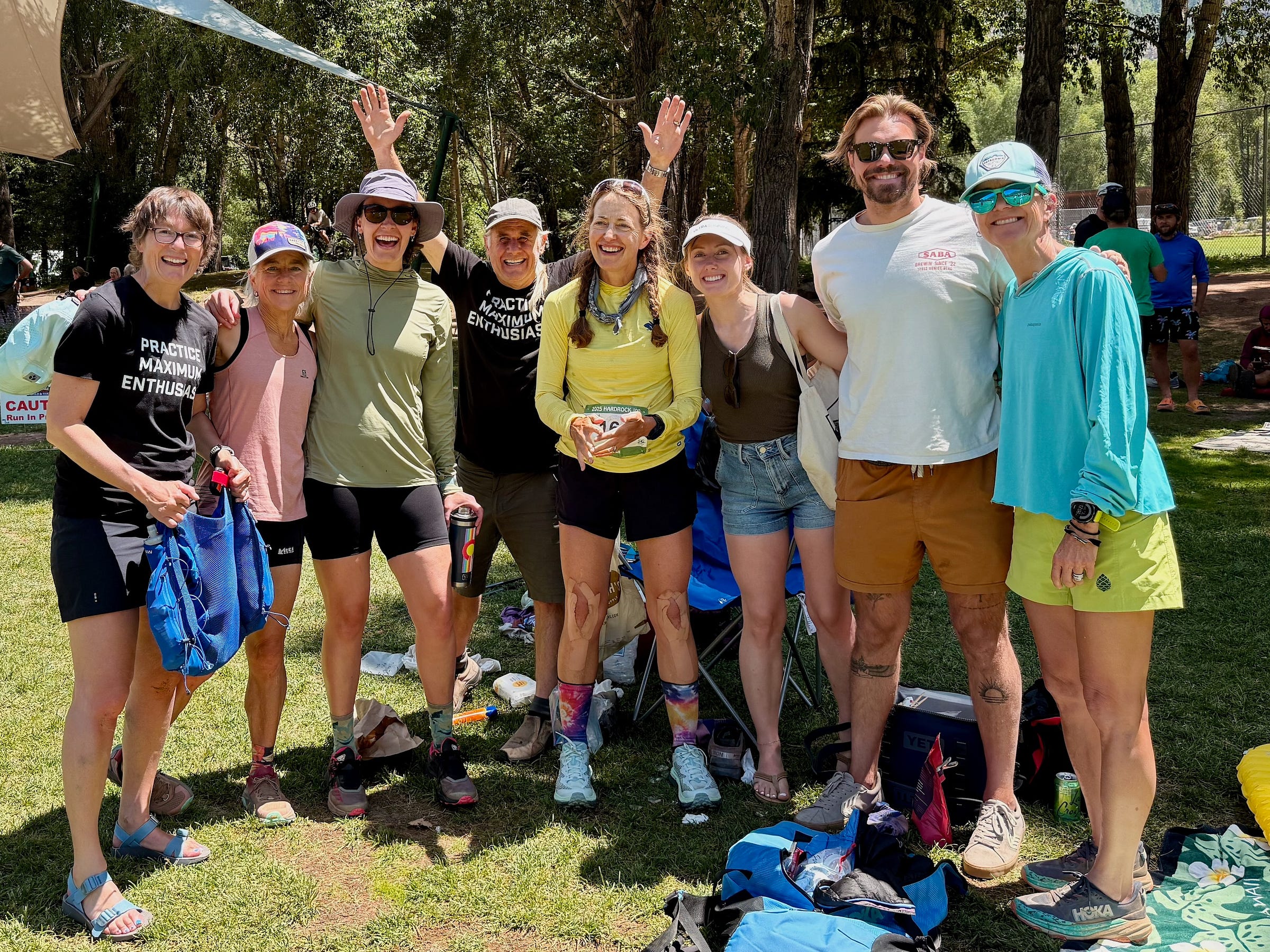
What happened?
I can’t tell you what really happened during the 46 hours I traversed the Hardrock Hundred route last Friday through early Sunday because the memories feel overwhelming. When my brain tries to picture and order all the trail segments, alpine vistas, hard-fought footsteps, aid station interactions, and other runners—through day then night then day then night—it makes me want to lie down and try for solid sleep that still eludes me. I can only attempt to piece together one storyline: the surprising development that almost made me drop, and how I kept going.
I also write with a feeling of inadequacy. Nothing I detail could capture what it was like out there. I had read reports, watched videos, and trained on all parts of the course, but nothing I studied beforehand conveyed what it was like to string the whole 102-mile route together and traverse it under 48 hours.
Nine major mountain passes, mostly at or above timberline. 33,197 feet of ascent and an equal amount of downhill. Those facts don’t mean much until you’re doing one after another after another and by the seventh major downhill (coming into Ophir down a 3,000-foot slope of chunky, wobbly rock with sharp crevices), you honestly don’t know how you can handle two more major mountain crossings and 15 more hours of this because your lower body and every toe feels pulverized, and you can’t stop your eyeballs from weirdly rolling so you blink repeatedly to focus vision until even your eyelids feel tired.
I thought I had planned and prepared for everything.
The binder of printouts for my crew and my well-organized gear bags took into account every contingency plan I could envision, from braces for strained knees and ankles to extra poles to replace mine that might break, to clothing layers for every weather, to psychological leverages. (For example, I had my friend Clare, a past Hardrocker, rehearse saying, “If [so-and-so] finished Hardrock, you can too,” and I gave her a list of names to fill in that blank. I also instructed her to shame me for DNFing the Ouray 100 in 2018.)
Most crucially, I had a detailed nutrition and hydration plan—with a pile of baggies full of various energy products to restock my pockets at the major aid stations— developed with a sports nutritionist to make sure I didn’t fall behind on carbs, didn’t lose my ability to sweat and pee, and didn’t lose my stomach.
I reminded myself to “expect the unexpected” and to adapt to surprises. An ultra plan is like a birth plan—you anticipate how it’ll go, and you prepare according to your preferences, but if the baby gets stuck, then you resort to any intervention necessary to save it.
So I took the first big surprise—the wildfire smoke at the start—in stride. I was so grateful and excited to start this event after being on the sidelines of it for so long. I felt so much admiration and camaraderie for the runners around me as we embarked on the first big ascent. I knew several of them, like Barbara Olmer, who in 2015 I had marveled at when I paced Clare because we saw her pumping breastmilk at the Governor Basin aid station in the middle of the night, back when one of her kids was a baby. And Amanda Grimes, who I met in 2014 when she was curled up in a ball on the shower floor of the Silverton gym, having just finished her first Hardrock in last place with 10 minutes to spare. Their past hard-fought finishes bolstered my belief that I could, too, and I felt kinship rather than competition.
Consequently, the first segments rolled along, and I felt strong and steady in spite of oppressive heat that blanketed us by afternoon. I was able to supplement my trail snacks (mainly gels, chews, and hydration mix) with food at aid stations. At Pole Creek (mile 20), for example, I asked a volunteer to make me PB&J rollup, heavy on jelly, in a burrito-sized tortilla, and I devoured it.
This video at the time stamp of 6:20 captures my positivity around mile 13 while ascending Buffalo Boy Ridge at 13,000 feet.
The biggest surprise of the day hit hard.
I got into Sherman aid station, mile 30, in 10 hours—about an hour later than I wanted to get there, but I knew I was managing the stressful heat and making fast enough progress to be well ahead of cutoffs. One of the extra-attentive and caring volunteers latched on to me to provide Hardrock’s famous “concierge service” of one-on-one help. He prepared my GU chocolate recovery drink with ice, handed me a popsicle, and took care of other things while I lubed my toes and changed socks.
To make conversation, I asked, “So how’s everything going with the day so far? Any surprises, any drama?”
His face turned strangely serious. “I don’t think you want to know,” he said.
I pushed back. “If it involves the organization, I actually do,” I said, because I know and care about the Hardrock leaders.
He took a deep breath. “Hardrock had its first fatality this morning,” he said.
“What? Was it a runner?”
He told me what he knew. A 60-year-old woman from Michigan named Elaine collapsed on the first mountain. SAR was summoned. A notice went out to aid stations over the com system to let them know she wouldn’t be coming through. Dale, the run director, had someone else read the announcement because he was too overcome with emotion to deliver it.
“I knew of her but didn’t know her,” I told him. “She was the only one of the six 60-plus women this year I hadn’t met yet.”
I thanked him and got out of the aid station while my mind stayed stuck on the summit of Little Giant, the day’s first mountain, and imagined scenarios of this female runner collapsing and the response of those around her. I pictured Dale Garland and guessed at the agony he must feel, and the crisis management he had to oversee.
The route exits Sherman on an exposed, light-colored gravel road that reflects heat. I was so preoccupied thinking of the tragedy that I kept running on that road at least a quarter mile past the left turn onto singletrack we were supposed to take. Eventually I realized my mistake, wasted more time checking the route on my GPS, and then backtracked feeling dejected. I got back on the proper route—a steep uphill—and felt profoundly tired, energy and enthusiasm drained.
Two things lifted my spirit: knowing I’d see my friend Yvonne Naughton at the next aid station, Burrows, where she volunteered; and, more profoundly, knowing that I was alive. That didn’t happen to you, I told myself. You are still here. You need to take care of yourself.
When I saw Yvonne—a two-time Hardrock finisher—I told her I needed a pep talk. My chin was quivery, and I was fighting back tears. I was so upset at the circumstances—the fatality, my missed turn out of Sherman, my late arrival to Burrows—that I had become upset about being upset. I didn’t want to feel drained and depressed only one-third of the way through.
“You really need to let go about any care about your time. You’re doing fine,” she reassured me, and described how far back in the pack she was at this point two years ago, during Hardrock’s hot 2023 edition. She and others got me to sit and eat something—I don’t remember what—and psyched me up to tackle the 4,000-foot ascent up to Handies, the 14,000-foot summit we faced. I wanted to get over Handies before dark, so I left Burrows soon after, feeling better.
I had traversed Handies in training, and not surprisingly, this time felt much slower and harder with the day’s tough earlier miles on my legs. But knowing what to expect from this segment of the route boosted my confidence and energy. I passed several other runners on the Handies ascent and felt my mood elevate as I admired the clusters of columbine and other flowers on the alpine tundra. The air cooled, which also provided relief. I needed to stop frequently to catch my breath—head hanging between trekking poles, whole body leaning into the uphill—yet I still made good time to the summit.
This is one of the few photos I took from the route, showing the view from the top of Handies at sunset in a smoke-tinged sky.
Then I ran as efficiently as I could down to Animus Forks (mile 44.5), where I’d see my crew and pick up a pacer. I turned on my headlamp midway down and navigated in the dark, grateful my ankles hadn’t sprained and knees didn’t ache too much. I got there around 10 p.m.
The crew party
The aid stations where my crew met me—Animus Forks, Ouray, Telluride, Chapman—became joyous celebrations. My husband Morgan, friend Clare, and pacer Suzanna met me at this one and had everything organized to prep for nighttime. I had bought Morgan and Clare T-shirts to wear that said “Practice Maximum Enthusiasm” (a reference to Brendan Leonard’s essay) as a visual reminder that I should be silly-enthusiastic and over-the-top positive about this crazy challenge. Morgan’s shirt was too small, and he kept lifting his arms to expose and shake his belly as if wearing a crop top, which was guaranteed to make me laugh.
Animus Forks aid station felt extra special because I had volunteered there in two prior years, and the captain Julie Blanda announced my arrival as if I were royalty. Several volunteers whom I know greeted me warmly. I felt so happy there, but I didn’t want to linger too long; I was eager to get up and over Engineer Pass. I drank a refreshing non-alcoholic beer my crew brought, and ate some of the aid station’s potato soup and a few bites of eggs.
Suzanna and I set out on the rocky mining road through the historic ghost town and began the fifth major climb of the route. I didn’t mind the uphill too much. I was more concerned about the relentless 5000-foot descent we faced to get down to Ouray, worried my legs would give out. Turns out, I was worrying about the wrong body part.
The first sign of trouble
My favorite simple-sugar energy snack is the gummy chews made by Scratch. I also consumed gels by GU and Never Second, and scoops of Tailwind and Scratch hydration mix in my water bottles, but the chews were central to my refueling plan. They go down easily and don’t get stuck in my molars. I’ve never not liked them.
Over Engineer Pass, however, I noticed something unpleasant about the Scratch chews: their sweet-and-sour granular coating was bugging my tongue, as if stinging it. I started swallowing them whole because it felt unpleasant to let them linger in my mouth. But I kept eating them, along with gels, because I needed the calories.
Suzanna and I crested Engineer and began the descent through an immense alpine basin that’s lovely in daytime but disorienting in the dark. As we approached the Engineer aid station (mile 51), I told Suzanna I didn’t want to stay there too long because I’d risk getting cold, but I should try to eat something. When we arrived, I attempted some soup and saltines.
Part of me felt enthusiastic to be halfway through the route, but the other part had an unsettled feeling of “uh-oh.” All at once, as I was sitting in an aid station chair, nausea hit, and I politely announced I was going to throw up.
Sometimes we vomit mid-ultra to empty overly-full stomaches, and it’s like turning a bucket upside down and generating a wave of water. My first puke felt different. It felt like a flame-thrower. Everything that came up and out of my throat flowed like a burning river and scorched my tongue.
I didn’t realize at the time, and only pieced together in hindsight, that every one of my much-needed trail snacks had a tangy-fruity flavor containing citric acid. My mouth, esophagus, and stomach began rejecting all that acid, and the gastric acid that I vomited felt caustic.
When it was out, I felt relieved, but didn’t feel like I could replace those stomach contents. The vomiting made me shiver and tense up all over, so I told Suzanna we had to move. She persuaded me to swallow a gel a little ways down the trail, which I did, but it took effort. It rekindled that burning feeling.
I tried to eat more saltines that I had taken from the aid station, but they were too dry to get many down. I needed a good ol’ banana or even better, a pint of vanilla ice cream. But all I had were fruity gels and chews (except for a few chocolate GUs, which went down better). When I tried to eat more Scratch chews, my tongue hurt because little sores had erupted on it.
Eventually we made it to Ouray (mile 59)—the low point elevation-wise on the course, just under 8000 feet— at 4:20 a.m., still a couple of hours behind the time I had hoped and planned to be in Ouray. My incredibly generous friend Cristal met us there while the rest of my crew slept. She had a camper parked next to the aid station, so I could crawl into it and rest. I definitely needed a quick nap, I told them.
I had put a GU recovery drink in my drop bag there, which she prepped, along with instant mashed potatoes. I drank the recovery shake, ate some spoonfuls of mashed potatoes, popped a 200mg caffeine pill (which would kick in after I woke), and asked them to let me cocoon alone in the dark of the camper for at least 10 minutes.
It was the weirdest nap of my life. First my body physically rebelled by convulsing and shivering while my brain flipped through a flashcard deck of images involving pink neon signs with words too blurry to read. Then all that shivering generated a blissful heat, my brain turned off, and I lost consciousness for around eight minutes that felt much longer.
I emerged from Cristal’s camper wearing fresh shoes and socks, as ready as I could be to tackle the second day.
I’ll skip through the deadening long miles on Camp Bird Road, and the ascent to the base of Virginius Pass, except to note I had another big puke, nearly splashing Suzanna’s feet, just after Governor Basin aid station (mile 66), followed by dry heaving that made my stomach clench and cramp. I approached the multi-level climb to Virginius feeling far too depleted to tackle it, and I concluded “the wheels are coming off” and I was doomed, just as I had been doomed around mile 66 of the Ouray 100 when I DNF’ed.
This was the first time I truly, deeply doubted I could finish, given the state I was in, but when I voiced those doubts to Suzanna, she didn’t indulge me. She was all business, saying in so many ways, “Just get to Telluride.”
In my mind, I searched for reasons why I should keep going rather than drop. I settled on the image of a lovely watercolor print of the Hardrock route, which I had bought for $100 the day before the event started. I wanted to hang it in my office and not view it as a picture of failure.
The climb to Virginius is so hard. The first two tiers are scree scrambles as steep, sketchy, and slippery as the better-known Grant Swamp Pass. By the time we got to the base of the final snow-covered pitch, the climb felt easier because I could grasp an affixed rope that hung for us.
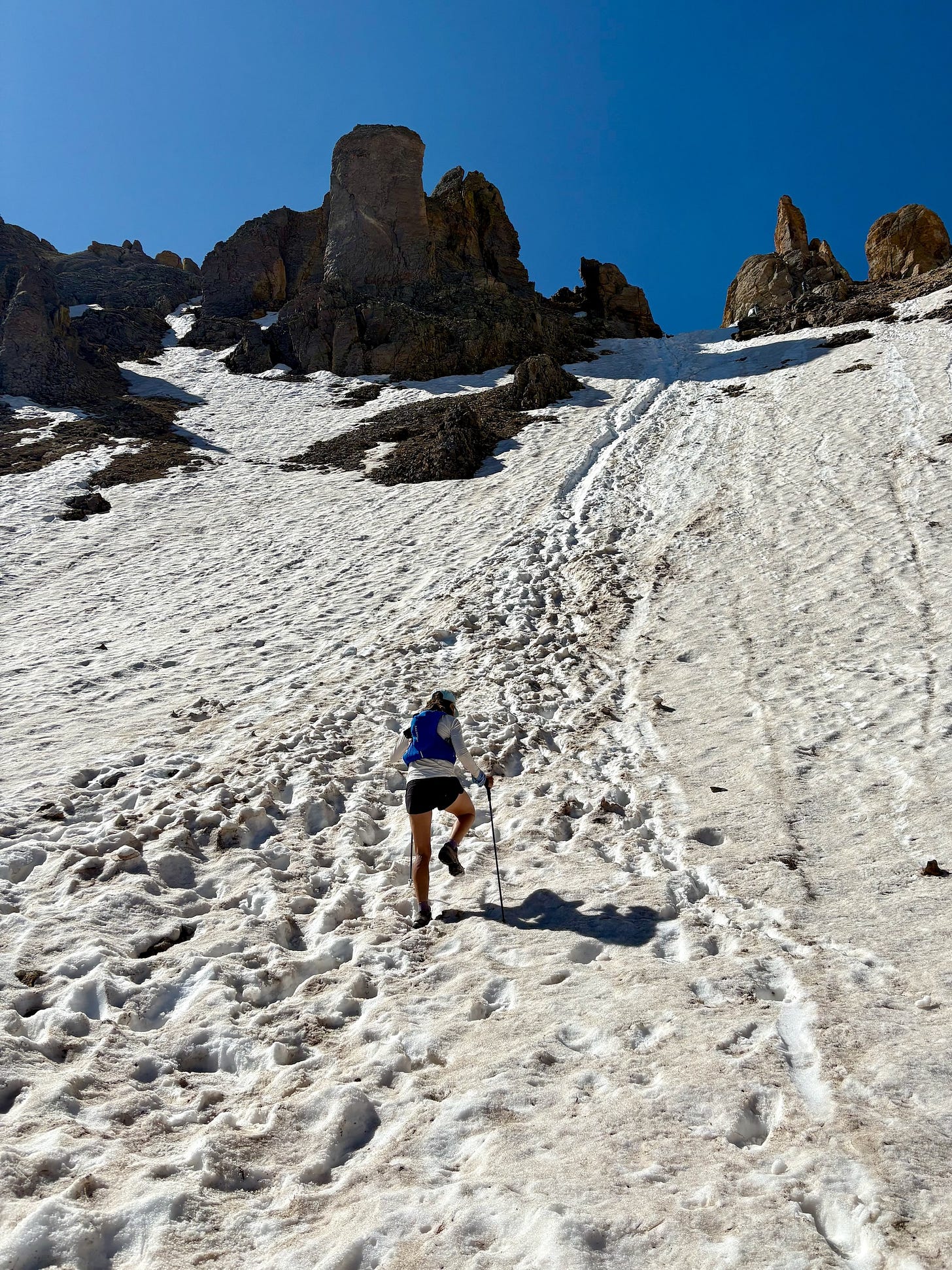
At Kroger’s Canteen aid station perched in the notch at the top, I tried to eat one of their famous perogies, I really did. But I only nibbled and felt repelled by the slimy texture. I wanted to get the hell down to Telluride.
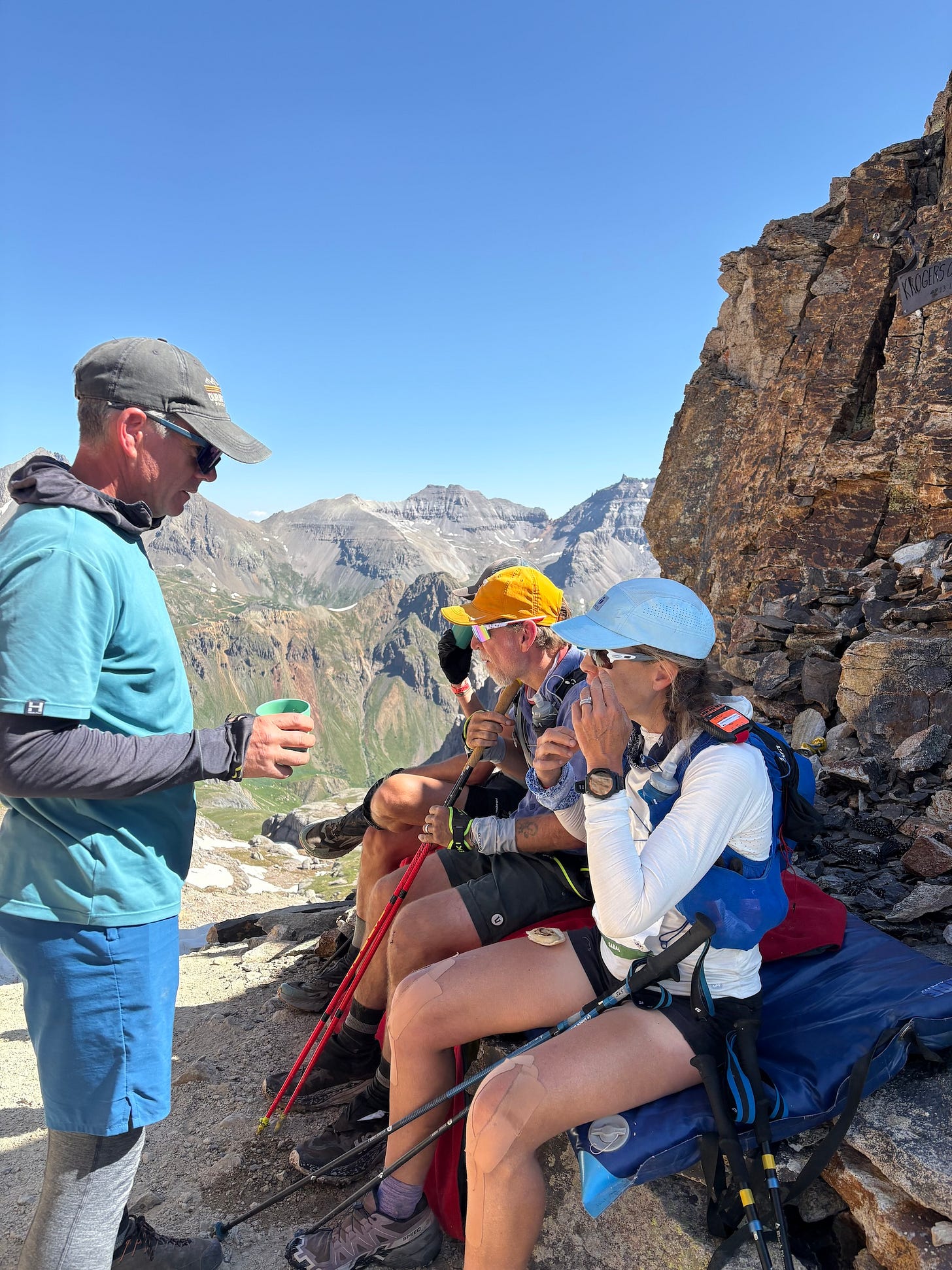
Coming down toward Telluride, I started to feel better, and locals I know started greeting me on the trail.
Then I hit the Telluride side streets and spotted my older brother David waiting in the shade to cheer me on. I started to cry and had to get past him to contain my emotions. Then at the post office, I saw my daughter Colly jumping up and down. More overwhelming emotion. Coming into Town Park, I felt like a celebrity. As soon as Morgan saw me, he did his funny shirt thing to show his belly, and I laughed and felt fully happy and relieved.
I mean, look at this pic and video—I had the most amazing crew! They cooled me down with ice, fixed my feet, changed my clothes, and fed me. I felt like a baby.
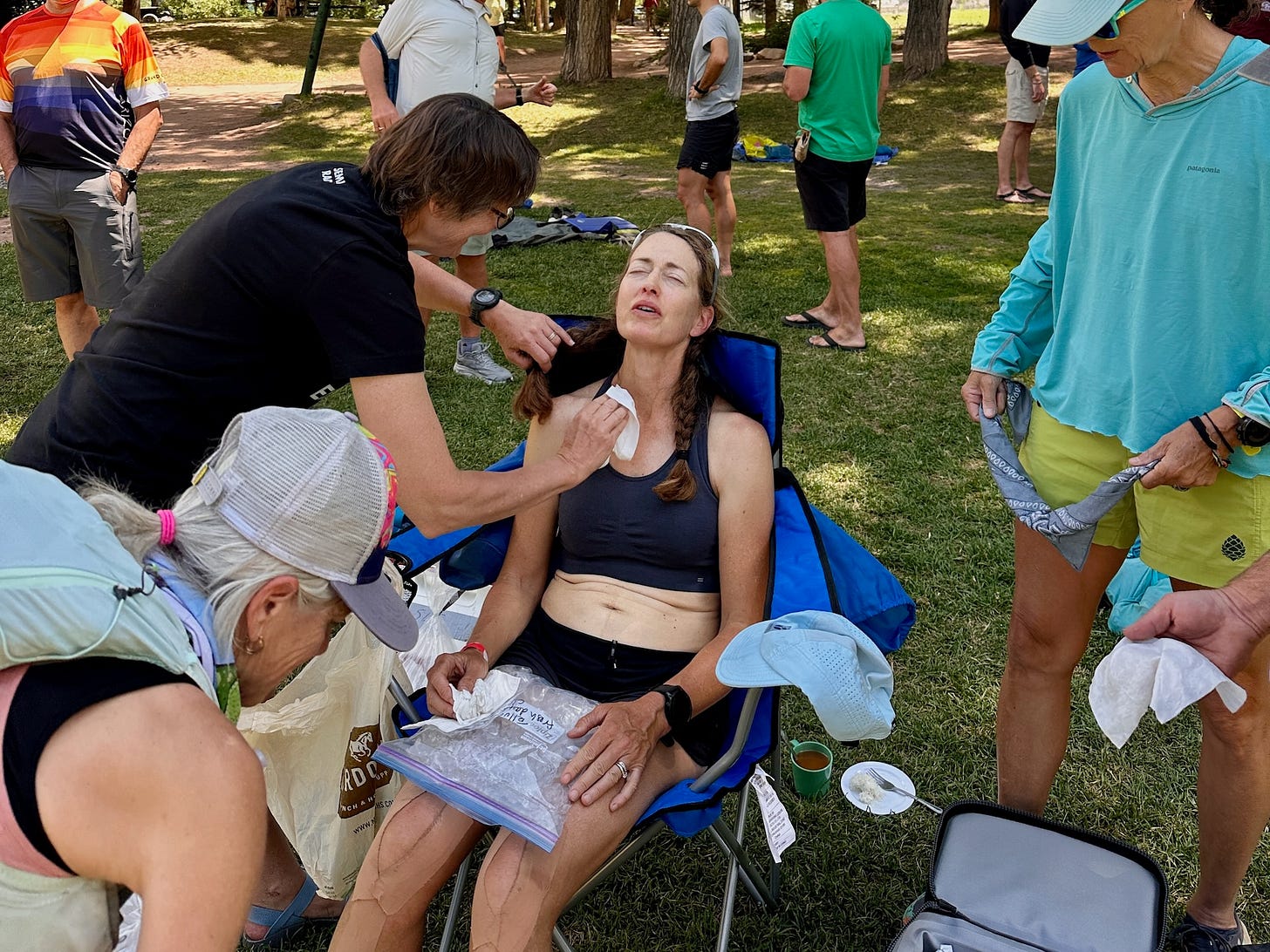
I had a few bites of croissant at Telluride, but the thing I craved and chugged was a pint of cold low-fat milk, another indication that I needed to neutralize the gastric acid that hurt my stomach and throat. A friend nearby watched me inhale the milk and remarked, “Geez, this could be a milk commercial!”
I headed out with Cristal as my pacer on the most-familiar-to-me part of the route, up the Wasatch Basin. We had crossed noon of the second day—the 30th hour—and once again, temps felt oppressively hot. We kept our pace ridiculously slow to manage the fatigue and heat.
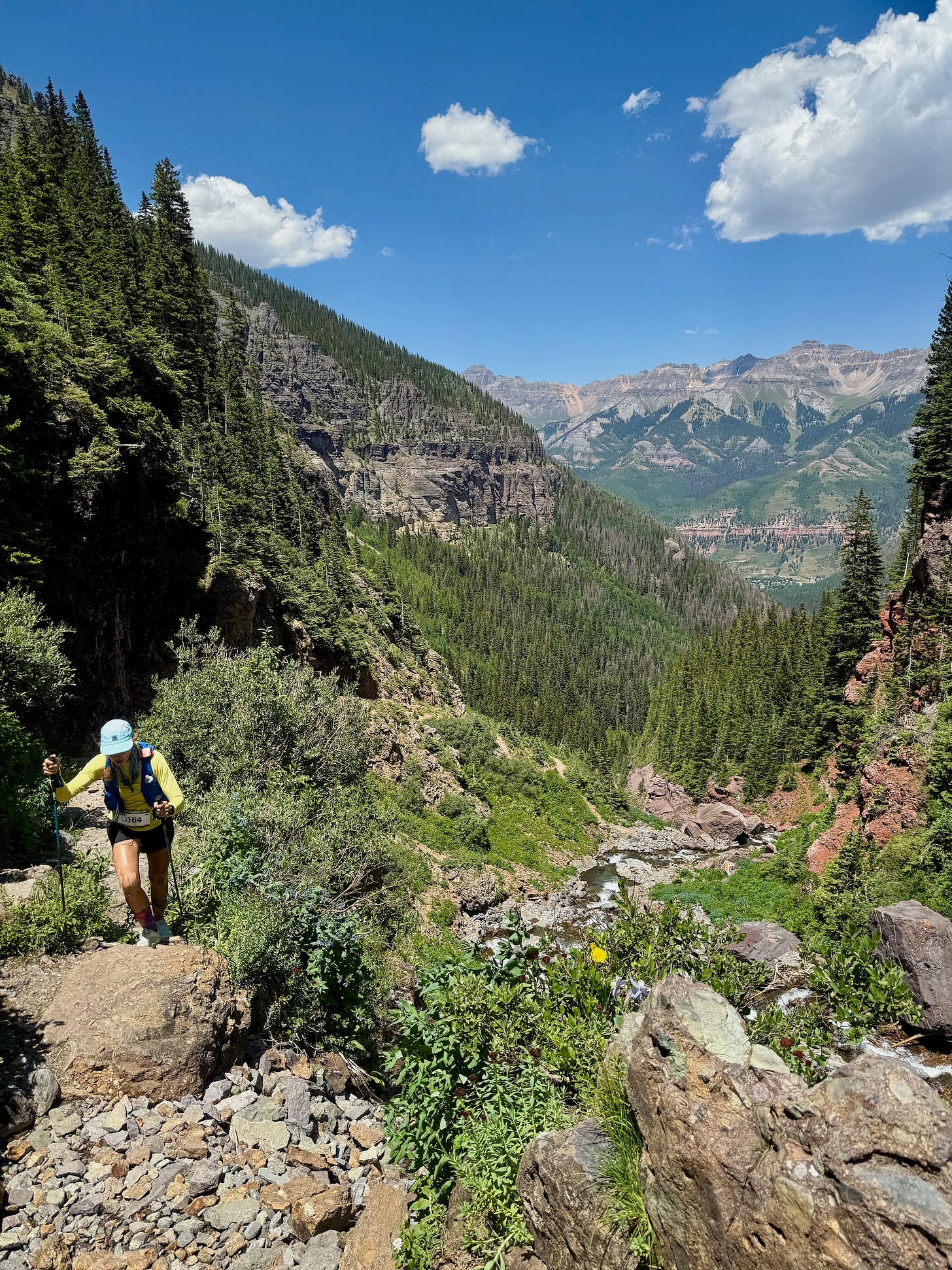
Around timberline, with another 1500 feet still to ascend before cresting at Oscar’s Pass, I sat on a rock, put my head between my knees, and threw up everything I had ingested since Telluride. Then I dry heaved. My tongue and throat felt swollen, with sores on my tongue scraping painfully against my molars, and I was losing my ability to talk louder than a whisper.
“Let’s go,” I told Cristal, to which she replied, “Wow. OK. Way to rally.”
My best, favorite moment on this mountain crossing came when we had to get down a snow field, and I chose to slide.
When we finally summited Oscar’s Pass before descending toward Ophir, I paused and asked her to take a photo to re-create the pose I struck when first pacing Hardrock here in 2011.
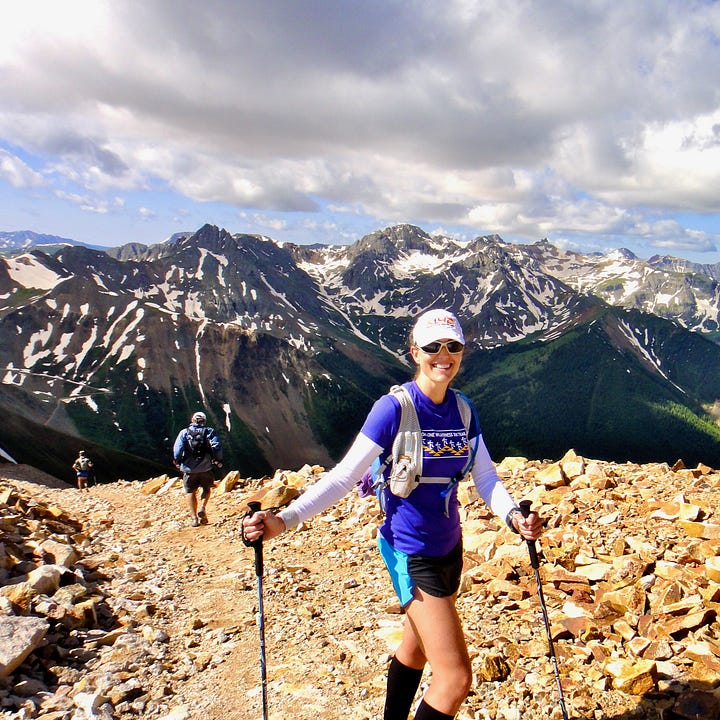
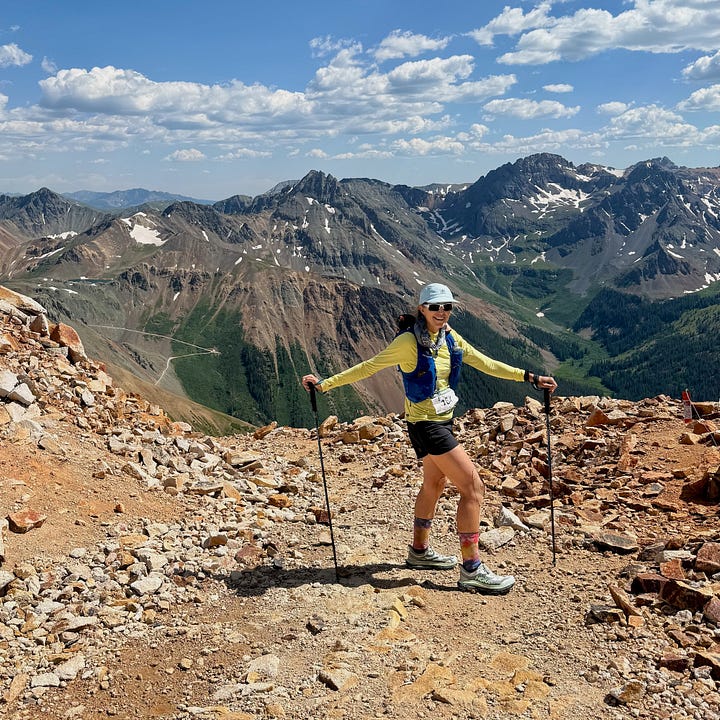
The spasmodic cat-cow
At Chapman Gulch aid station (mile 84), the crew tried to work their magic but could barely cheer me up. I was drained and feeling hopeless about my ability to handle the final two massive mountain crossings. Of all the things I had anticipated might hurt, I didn’t expect it to be my mouth, throat, and stomach. I tried to drink another icy GU recovery shake, and to eat some bites of soup with rice, but I didn’t get much down. I left the aid station with Sophie as my final pacer, feeling hot and bothered because I had changed into capris for the night, and they felt too hot and tight.
Sophie was a trooper. She entertained me with news from the day. She also forced me to swallow more gels for their calories, which I did, and she reminded me to drink, which I also did. We connected with
(who also has a Substack, ), and his nice pacer, Leon Lutz, who took this great pic of Sophie and me starting up the Grant Swamp Pass scree headwall.The 13,140-foot ridge at the top of the pass provides an iconic view of Island Lake on one side, Oscar’s Pass on the other. It’s one of the most photographed spots on the Hardrock route. But when I got up there, I didn’t care about the view because I was on my hands and knees while doing a spasmodic cat-cow and heaving again. I violated Leave No Trace by depositing a big puddle of gastric acid up there.
Going down the other side shakily, I spotted Billy Yang, the filmmaker and friend I’ve known since the early 2010s. He looked euphoric and hollered repeatedly, “Sarah! You’re finishing Hardrock! You’re finally doing it! Isn’t this amazing! I need your picture! You’re a Hardrocker!”
Barely audible, I mustered, “You mean, geriatric walker.”
“No! You’re a legend!”
Our vibes were so out of synch, part of me found it funny. But I told him in all seriousness, “Billy, this isn’t in the bag for me yet.”
He raved like a madman, “Don’t say that! Yes it is!!!!”
Billy was waiting for his wife Hilary, whom I had passed on Engineer Pass when she was struggling, but now she was charging ahead and feeling like a new person. She looked so thrilled and vibrant when she and her pacer Emily Hawgood passed me, followed by exuberant Billy, that I felt an almost maternal happiness for them all. I thought about what good kids they are with bright futures, as if they were barely young adults and I were an octogenarian friend of their parents, because that’s how aged and out of it I felt.
Darkness fell, the Kamm Traverse leading to the next aid station seemed interminable, and I started weaving and stumbling. I needed to close my eyes. When we finally got to the KT aid station (mile 91), I insisted on a nap. Sophie was skeptical, telling me I’d stiffen up and we should keep moving. I didn’t care. I crawled into the med tent and passed out for 10 minutes.
When I emerged, a bunch of other runners had gotten ahead of me. I still didn’t care. I had a few bites of soup with crackers, left the aid station, and plunged into the icy calf-high river at the base of the next and final mountain pass, which momentarily made me more alert.
Patches of overgrown willow, which we had to push through, blocked parts of the two-tiered climb up Porcupine Pass to Putnam Ridge, and some of those in-your-face willow spots surprised us with shoe-sucking mud. My feet sunk in mud past my crew socks, and I could feel my heels slipping out of their shoes. It took every bit of concentration to lift my feet out of the mud with the shoes still attached.
Sophie begged me to eat and drink, so I did. But then I vomited more, with animalistic heaving noises that embarrassed even me. My stomach felt squeezed and twisted.
It ain’t over ’til it’s over
Foothold by foothold and cairn by cairn, we made it up to the 12,600-foot Putnam Ridge, the rising full moon a beacon. I wasted more time by repeatedly taking my windbreaker off then putting it on again then getting too hot and ripping it off.
You’d think I’d be happy to get to the final aid station, Putnam, with just about five and a half miles to go. I actually was happy to drink a cup of Coke there. But I still didn’t believe I could finish because I feared collapsing and passing out. I had only self-doubt, none of the self-confidence or self-efficacy I had coached myself to stoke.
I thought of the phrase “it ain’t over ‘til it’s over,” which in ultras I normally take to mean we’ll keep moving and not give up until we’re actually timed out. In the final miles of Hardrock, however, I interpreted it as proof that I can’t be assured I’ll make it until it’s actually over and I’m at the finish.
It’s worth noting that I was hallucinating wildly. Every boulder and every tree trunk sported spots and lines that formed two eyes and a mouth, so smiley faces surrounded and stared at me. To avoid their gaze, I tried to keep my eyes down on the trail. But I kept seeing rocks and branches in the trail as objects that other runners had dropped. I’d think, “There’s a wallet, there’s a shoe, maybe I should pick it up and take it to the finish.”
I wanted to talk to Sophie about it, but I could no longer raise my voice because my throat burned badly and tongue felt oversized, so we moved in silence, until I involuntarily produced more supernatural retching noises.
At least we weren’t too close to the cutoff. It would be so stressful, I more lucidly realized, to be one of the runners behind me who had to push their pace to finish under the 48-hour cutoff, and to have to really run the rock-pile talus fields that covered the trail in parts of the final miles.
This is the last and only time you have to do this, I comforted myself by thinking. As I thought about doing Hardrock, “one and done” emerged as a mantra in my head.
Approaching the finish, I wasn’t thinking profound thoughts or experiencing deep emotions. I couldn’t process the meaning of the odyssey to get to this point. I was thinking only of our hotel room and Morgan and how excited I was to be with him and take a shower.
Then, as I got closer and made the final turn, I was thinking, “Don’t puke on Dale, don’t puke on Dale.”
I couldn’t fully revel in the relief of finishing, or appreciate the cheering people who stayed up for me at 4 a.m., because I worried the livestream might film me heaving and making those crazy throw-up noises again.
After 46 hours and five minutes, I made it and engaged in the finishers’ tradition of kissing the rock. I proved to myself again—in hands-down the hardest ultra test yet—that moving step by step, no matter how slow, always adds up to progress and gets you there. Your body always can do more than you think it can. You can finish what you set out to do.
Dale pulled me in for a hug, and I swallowed hard and whispered, “Thank you.”

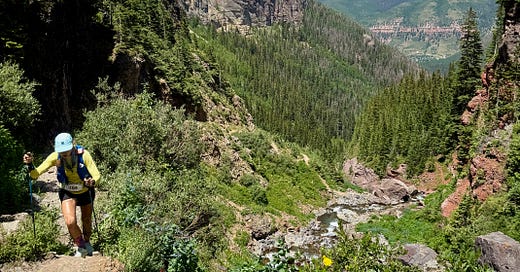








Loved reading this. A zillion congratulations again. Your analogy of a birth-plan made me laugh out loud. How true. When it comes down to it…you just find a way to finish. And Morgan looked fabulous in his shirt too.
Thanks for being so open with this report — it helps to know I wasn’t the only one feeling some of these things. The planning and training and feeling ready, followed (very early in the run) by the realization that this was going to be a different experience than the one I’d visualized so often. The slow agony of those endless gasping climbs, the super-sore throat, lost voice…. Anyway, we got through it (and I take consolation from what Sophie pointed out, maybe at the base of Grant Swamp Pass — when you say you finished Hardrock, no one asks what your time was). I’m still making my way home (about to take off from Dallas to Pittsburgh, and trying hard not to cough so much and scare everyone). Your experience helps give me perspective on my own, which I’m still trying to fully understand — thanks, and congratulations.